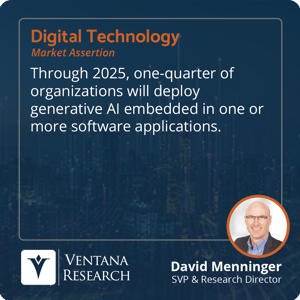Generative AI is a class of artificial intelligence used to generate new, seemingly real content. Broadly speaking, AI has traditionally been used to identify patterns in data and apply those patterns to categorize and predict behaviors. For instance, it can organize customers into groups (or clusters) with similar characteristics, or predict which customers are most likely to respond to certain offers.
As the name implies, generative AI can be used to create content, including text, digital images, audio, video or even computer programs and models with artificial intelligence and machine learning. It has been  popularized recently by various emerging applications such as ChatGPT and DALL-E. ChatGPT is a chatbot that generates text in response to natural language queries or instructions. DALL-E generates images in response to natural language instructions. While these applications may be novelties at the moment, we expect the adoption of generative AI to grow rapidly. We assert that through 2025, one-quarter of organizations will deploy generative AI embedded in one or more software applications.
popularized recently by various emerging applications such as ChatGPT and DALL-E. ChatGPT is a chatbot that generates text in response to natural language queries or instructions. DALL-E generates images in response to natural language instructions. While these applications may be novelties at the moment, we expect the adoption of generative AI to grow rapidly. We assert that through 2025, one-quarter of organizations will deploy generative AI embedded in one or more software applications.
It's worth understanding how generative models work to understand their value and applications. Generative AI uses a variety of deep-learning algorithms. One class of algorithms – considered the genesis of this category – is referred to as generative adversarial networks. A key aspect of GANs is that they are actually composed of two separate neural networks: a generator and a discriminator. The generator learns to produce plausible data. The discriminator learns to distinguish between fake and real data. The term adversarial refers to the competition between these two elements: The development process involves iterating between revising each of the networks, where feedback between the two improves the accuracy of both.
Another aspect of generative AI is that it works on “unlabeled data.” One of the challenges in preparing data for many data science use cases and algorithms is that data must be “labeled.” For example, photos must be labeled for their contents: Is this a picture of a cat or a muffin? Text must be labeled to identify parts of speech and whether the text is a name of a person or place. Audio clips must be labeled to distinguish between words in a specific language or a dog barking. The data-labeling process can be tedious and resource-intensive.
Eliminating the need to label data reduces the human resources required. However, it can increase the amount of computer resources needed, since the model development process puts more burden on the computing resources to go through the trial and error process, pitting the generator and the discriminator against each other. For broad applications, it may also require very large amounts of data to generate (and discriminate) more new types of data. These conditions could lead to heavy demands for computing resources, which makes the development process expensive.
With these advances comes an elevated need to govern and control data used for generative AI. If organizations allow individuals to use data in an uncontrolled manner, it could mean that corporate data is exposed to – and used by – others, including competitors.
Generative AI can be applied to a variety of use cases, including natural language processing for search and voice assistants. It can be used for idea generation, producing a starting point for others to develop further, whether that starting point is a written piece of material, a new logo for a business, a jingle for a commercial or a clip for a video game. It has the opportunity for contact centers to more rapidly assemble responses to customers. Generative AI can also be used to create computer programs or even AI models. In future perspectives, we’ll look at other types of algorithms, including large language models which are driving a lot of interest in this area. In the meantime, organizations should learn about generative AI and experiment with business processes and engagement inside and outside the business to be prepared to adopt this exciting new technology as it becomes more widely available.
Regards,
David Menninger

 popularized recently by various emerging applications such as ChatGPT and DALL-E. ChatGPT is a chatbot that generates text in response to natural language queries or instructions. DALL-E generates images in response to natural language instructions. While these applications may be novelties at the moment, we expect the adoption of generative AI to grow rapidly. We assert that through 2025, one-quarter of organizations will deploy generative AI embedded in one or more software applications.
popularized recently by various emerging applications such as ChatGPT and DALL-E. ChatGPT is a chatbot that generates text in response to natural language queries or instructions. DALL-E generates images in response to natural language instructions. While these applications may be novelties at the moment, we expect the adoption of generative AI to grow rapidly. We assert that through 2025, one-quarter of organizations will deploy generative AI embedded in one or more software applications.








